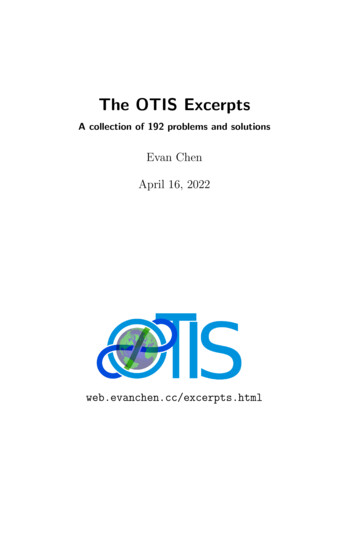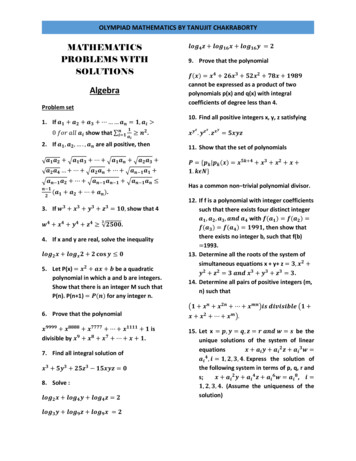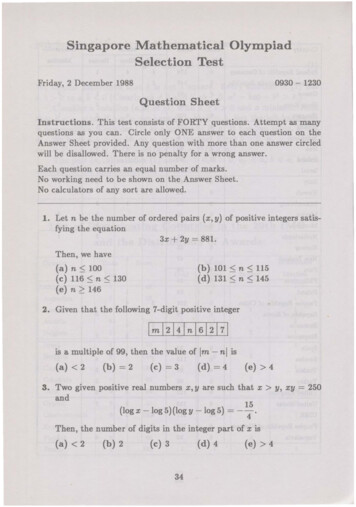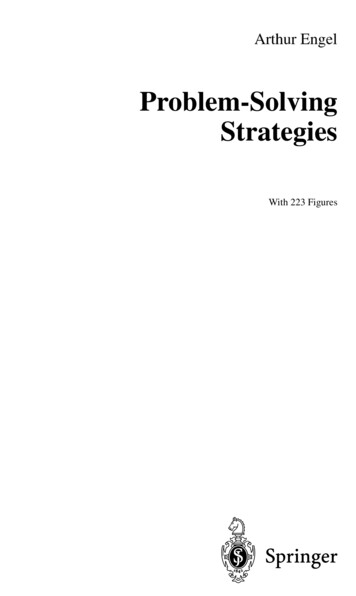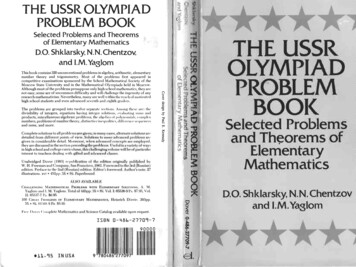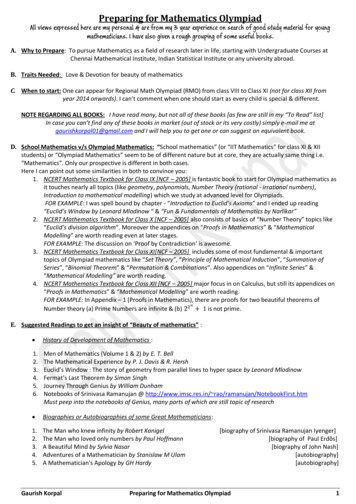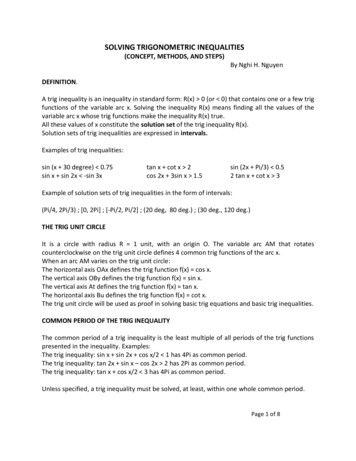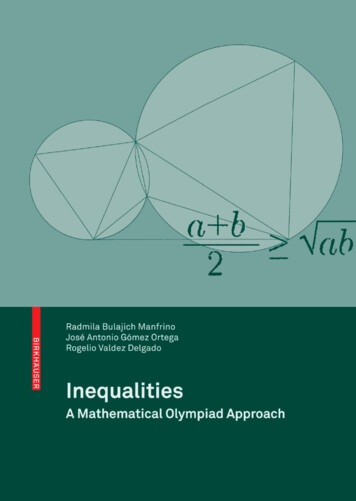
Transcription
Radmila Bulajich ManfrinoJosé Antonio Gómez OrtegaRogelio Valdez DelgadoInequalitiesA Mathematical Olympiad ApproachBirkhäuserBasel · Boston · Berlin
Autors:Radmila Bulajich ManfrinoRogelio Valdez DelgadoFacultad de CienciasUniversidad Autónoma Estado de MorelosAv. Universidad 1001Col. Chamilpa62209 Cuernavaca, MorelosMéxicoe-mail: bulajich@uaem.mxvaldez@uaem.mxJosé Antonio Gómez OrtegaDepartamento de MatemàticasFacultad de Ciencias, UNAMUniversidad Nacional Autónoma de MéxicoCiudad Universitaria04510 México, D.F.Méxicoe-mail: jago@fciencias.unam.mx2000 Mathematical Subject Classification 00A07; 26Dxx, 51M16Library of Congress Control Number: 2009929571Bibliografische Information der Deutschen BibliothekDie Deutsche Bibliothek verzeichnet diese Publikation in der Deutschen Nationalbibliografie; detaillierte bibliografische Daten sind im Internet über http://dnb.ddb.de abrufbar.ISBN 978-3-0346-0049-1 Birkhäuser Verlag, Basel – Boston – BerlinThis work is subject to copyright. All rights are reserved, whether the whole or part of thematerial is concerned, specifically the rights of translation, reprinting, re-use of illustrations, recitation, broadcasting, reproduction on microfilms or in other ways, and storagein data banks. For any kind of use permission of the copyright owner must be obtained. 2009 Birkhäuser Verlag AGBasel · Boston · BerlinPostfach 133, CH-4010 Basel, SchweizEin Unternehmen von Springer Science Business MediaGedruckt auf säurefreiem Papier, hergestellt aus chlorfrei gebleichtem Zellstoff. TCF Printed in GermanyISBN 978-3-0346-0049-1e-ISBN 978-3-0346-0050-7987654321www.birkhauser.ch
IntroductionThis book is intended for the Mathematical Olympiad students who wish to prepare for the study of inequalities, a topic now of frequent use at various levelsof mathematical competitions. In this volume we present both classic inequalitiesand the more useful inequalities for confronting and solving optimization problems. An important part of this book deals with geometric inequalities and thisfact makes a big difference with respect to most of the books that deal with thistopic in the mathematical olympiad.The book has been organized in four chapters which have each of them adifferent character. Chapter 1 is dedicated to present basic inequalities. Most ofthem are numerical inequalities generally lacking any geometric meaning. However, where it is possible to provide a geometric interpretation, we include it aswe go along. We emphasize the importance of some of these inequalities, such asthe inequality between the arithmetic mean and the geometric mean, the CauchySchwarz inequality, the rearrangement inequality, the Jensen inequality, the Muirhead theorem, among others. For all these, besides giving the proof, we presentseveral examples that show how to use them in mathematical olympiad problems. We also emphasize how the substitution strategy is used to deduce severalinequalities.The main topic in Chapter 2 is the use of geometric inequalities. There we apply basic numerical inequalities, as described in Chapter 1, to geometric problemsto provide examples of how they are used. We also work out inequalities whichhave a strong geometric content, starting with basic facts, such as the triangleinequality and the Euler inequality. We introduce examples where the symmetrical properties of the variables help to solve some problems. Among these, we payspecial attention to the Ravi transformation and the correspondence between aninequality in terms of the side lengths of a triangle a, b, c and the inequalitiesthat correspond to the terms s, r and R, the semiperimeter, the inradius and thecircumradius of a triangle, respectively. We also include several classic geometricproblems, indicating the methods used to solve them.In Chapter 3 we present one hundred and twenty inequality problems thathave appeared in recent events, covering all levels, from the national and up tothe regional and international olympiad competitions.
viIntroductionIn Chapter 4 we provide solutions to each of the two hundred and ten exercises in Chapters 1 and 2, and to the problems presented in Chapter 3. Most ofthe solutions to exercises or problems that have appeared in international mathematical competitions were taken from the official solutions provided at the timeof the competitions. This is why we do not give individual credits for them.Some of the exercises and problems concerning inequalities can be solved using different techniques, therefore you will find some exercises repeated in differentsections. This indicates that the technique outlined in the corresponding sectioncan be used as a tool for solving the particular exercise.The material presented in this book has been accumulated over the last fifteen years mainly during work sessions with the students that won the nationalcontest of the Mexican Mathematical Olympiad. These students were developing their skills and mathematical knowledge in preparation for the internationalcompetitions in which Mexico participates.We would like to thank Rafael Martı́nez Enrı́quez, Leonardo Ignacio Martı́nezSandoval, David Mireles Morales, Jesús Rodrı́guez Viorato and Pablo SoberónBravo for their careful revision of the text and helpful comments for the improvement of the writing and the mathematical content.
ContentsIntroduction1 Numerical Inequalities1.1 Order in the real numbers . . . . . .1.2 The quadratic function ax2 2bx c1.3 A fundamental inequality,arithmetic mean-geometric mean . .1.4 A wonderful inequality:The rearrangement inequality . . . .1.5 Convex functions . . . . . . . . . . .1.6 A helpful inequality . . . . . . . . .1.7 The substitution strategy . . . . . .1.8 Muirhead’s theorem . . . . . . . . .vii. . . . . . . . . . . . . . . . . . . . . . . . . . . . . . . . .114. . . . . . . . . . . . . . . . .7.13203339432 Geometric Inequalities2.1 Two basic inequalities . . . . . . . . . . . . . . . . . .2.2 Inequalities between the sides of a triangle . . . . . . .2.3 The use of inequalities in the geometry of the triangle2.4 Euler’s inequality and some applications . . . . . . . .2.5 Symmetric functions of a, b and c . . . . . . . . . . . .2.6 Inequalities with areas and perimeters . . . . . . . . .2.7 Erdős-Mordell Theorem . . . . . . . . . . . . . . . . .2.8 Optimization problems . . . . . . . . . . . . . . . . . .5151545966707580883 Recent Inequality Problems.1014 Solutions to Exercises and Problems1174.1 Solutions to the exercises in Chapter 1 . . . . . . . . . . . . . . . . 1174.2 Solutions to the exercises in Chapter 2 . . . . . . . . . . . . . . . . 1404.3 Solutions to the problems in Chapter 3 . . . . . . . . . . . . . . . . 162Notation205
viiiContentsBibliography207Index209
Chapter 1Numerical Inequalities1.1 Order in the real numbersA very important property of the real numbers is that they have an order. Theorder of the real numbers enables us to compare two numbers and to decide whichone of them is greater or whether they are equal. Let us assume that the realnumbers system contains a set P , which we will call the set of positive numbers,and we will express in symbols x 0 if x belongs to P . We will also assume thefollowing three properties.Property 1.1.1. Every real number x has one and only one of the following properties:(i) x 0,(ii) x P (that is, x 0),(iii) x P (that is, x 0).Property 1.1.2. If x, y P , then x y P (in symbols x 0, y 0 x y 0).Property 1.1.3. If x, y P , then xy P (in symbols x 0, y 0 xy 0).If we take the “real line” as the geometric representation of the real numbers,by this we mean a directed line where the number “0”has been located and servesto divide the real line into two parts, the positive numbers being on the sidecontaining the number one “1”. In general the number one is set on the right handside of 0. The number 1 is positive, because if it were negative, since it has theproperty that 1 · x x for every x, we would have that any number x 0 wouldsatisfy x P and x P , which contradicts property 1.1.1.Now we can define the relation a is greater than b if a b P (in symbolsa b). Similarly, a is smaller than b if b a P (in symbols a b). Observe that
2Numerical Inequalitiesa b is equivalent to b a. We can also define that a is smaller than or equal tob if a b or a b (using symbols a b).We will denote by R the set of real numbers and by R the set P of positivereal numbers.Example 1.1.4.(i) If a b and c is any number, then a c b c.(ii) If a b and c 0, then ac bc.In fact, to prove (i) we see that a c b c (b c) (a c) 0 b a 0 a b. To prove (ii), we proceed as follows: a b b a 0 andsince c 0, then (b a)c 0, therefore bc ac 0 and then ac bc.Exercise 1.1. Given two numbers a and b, exactly one of the following assertionsis satisfied, a b, a b or a b.Exercise 1.2. Prove the following assertions.(i) a 0, b 0 ab 0.(ii) a 0, b 0 ab 0.(iii) a b, b c a c.(iv) a b, c d a c b d.(v) a b b a.1 0.a1(vii) a 0 0.a(vi) a 0 a 0.b(ix) 0 a b, 0 c d ac bd.(viii) a 0, b 0 (x) a 1 a2 a.(xi) 0 a 1 a2 a.Exercise 1.3.(i) If a 0, b 0 and a2 b2 , then a b.(ii) If b 0, we have thatab 1 if and only if a b.The absolute value of a real number x, which is denoted by x , is defined as xif x 0, x x if x 0.Geometrically, x is the distance of the number x (on the real line) from the origin0. Also, a b is the distance between the real numbers a and b on the real line.
1.1 Order in the real numbers3Exercise 1.4. For any real numbers x, a and b, the following hold.(i) x 0, and is equal to zero only when x 0.(ii) x x .2(iii) x x2 .(iv) ab a b . a a (v) , with b 0.b b Proposition 1.1.5 (Triangle inequality). The triangle inequality states that for anypair of real numbers a and b, a b a b .Moreover, the equality holds if and only if ab 0.Proof. Both sides of the inequality are positive; then using Exercise 1.3 it is sufficient to verify that a b 2 ( a b )2 :22222 a b (a b)2 a2 2ab b2 a 2ab b a 2 ab b 222 a 2 a b b ( a b ) .In the previous relations we observe only one inequality, which is obvious sinceab ab . Note that, when ab 0, we can deduce that ab ab a b , and thenthe equality holds. The general form of the triangle inequality for real numbers x1 , x2 , . . . , xn ,is x1 x2 · · · xn x1 x2 · · · xn .The equality holds when all xi ’s have the same sign. This can be proved in a similarway or by the use of induction. Another version of the last inequality, which isused very often, is the following: x1 x2 · · · xn x1 x2 · · · xn .Exercise 1.5. Let x, y, a, b be real numbers, prove that(i) x b b x b,(ii) a b a b ,(iii) x2 xy y 2 0,(iv) x 0, y 0 x2 xy y 2 0.Exercise 1.6. For real numbers a, b, c, prove that a b c a b b c c a a b c 0.
4Numerical InequalitiesExercise 1.7. Let a, b be real numbers such that 0 a b 1. Prove thatb a 1,1 abab(ii) 0 1,1 b 1 a1(iii) 0 ab2 ba2 .4(i) 0 Exercise 1.8. Prove that if n, m are positive integers, then 2 m 2nm n .mn 2 if and only ifExercise 1.9. If a b, x y, then ax by ay bx. 2 2Exercise 1.10. If x, y 0, then xy yx x y.Exercise 1.11. (Czech and Slovak Republics, 2004) Let a, b, c, d be real numberswith a d b c, prove that(a b)(c d) (a c)(b d) (d a)(b c) 0.Exercise 1.12. Let f (a, b, c, d) (a b)2 (b c)2 (c d)2 (d a)2 . Fora b c d, prove thatf (a, c, b, d) f (a, b, c, d) f (a, b, d, c).Exercise 1.13. (IMO, 1960) For which real values of x the following inequalityholds:4x2 2x 9?(1 1 2x)2 Exercise 1.14. Prove that for any positive integer n, the fractional part of 4n2 nis smaller than 14 .Exercise 1.15. (Short list IMO, 1996) Let a, b, c be positive real numbers suchthat abc 1. Prove thatabbcca 1.a5 b5 ab b5 c5 bc c5 a5 ca1.2 The quadratic function ax2 2bx cOne very useful inequality for the real numbers is x2 0, which is valid for anyreal number x (it is sufficient to consider properties 1.1.1, 1.1.3 and Exercise 1.2of the previous section). The use of this inequality leads to deducing many otherinequalities. In particular, we can use it to find the maximum or minimum of aquadratic function ax2 2bx c. These quadratic functions appear frequently inoptimization problems or in inequalities.
1.2 The quadratic function ax2 2bx c5One common example consists in proving that if a 0, the quadratic function2ax2 2bx c will have its minimum at x ab and the minimum value is c ba .In fact, bb2b222ax 2bx c a x 2 x 2 c aaa 2 2bb c . a x aa 2Since x ab 0 and the minimum value of this expression, zero, is attainedwhen x ab , we conclude that the minimum value of the quadratic function is2c ba .If a 0, the quadratic function ax2 2bx c will have a maximum at x ab 222and its value at this point is c ba . In fact, since ax2 2bx c a x ab c ba 2 and since a x ab 0 (because a 0), the greatest value of this last expression2is zero, thus the quadratic function is always less than or equal to c ba andassumes this value at the point x ab .Example 1.2.1. If x, y are positive numbers with x y 2a, then the product xyis maximal when x y a.If x y 2a, then y 2a x. Hence, xy x(2a x) x2 2ax (x a)2 a2 has a maximum value when x a, and then y x a.This can be interpreted geometrically as “of all the rectangles with fixedperimeter, the one with the greatest area is the square”. In fact, if x, y are thelengths of the sides of the rectangle, the perimeter is 2(x y) 4a, and its areais xy, which is maximized when x y a.Example 1.2.2. If x, y are positive numbers with xy 1, the sum x y is minimalwhen x y 1.2 It follows that x y x x1 x 1x 2, and then x y is minimal when x 1x 0, that is, when x 1. Therefore,x y 1.If xy 1, then y 1x.This can also be interpreted geometrically in the following way, “of all therectangles with area 1, the square has the smallest perimeter”. In fact, if x, y arethe lengths of the sides of the rectangle, its area is xy 1 and its perimeter is2 x 1x 2 4. Moreover, the perimeter is 4 if2(x y) 2 x x1 2 and only if x 1x 0, that is, when x y 1.Example 1.2.3. For any positive number x, we have x 1x 2.
6Numerical Inequalities2 x 1x 2 2. Moreover, the equality holds ifObserve that x x1 and only if x 1x 0, that is, when x 1.Example 1.2.4. If a, b 0, thena b.ab ba 2, and the equality holds if and only ifIt is enough to consider the previous example with x ab .Example 1.2.5. Given a, b, c 0, it is possible to construct a triangle with sidesof length a, b, c if and only if pa2 qb2 pqc2 for any p, q with p q 1.Remember that a, b and c are the lengths of the sides of a triangle if andonly if a b c, a c b and b c a.LetQ pa2 qb2 pqc2 pa2 (1 p)b2 p(1 p)c2 c2 p2 (a2 b2 c2 )p b2 ,therefore Q is a quadratic function1 in p andQ 0 2 a2 b2 c2 4b2 c2 0 a2 b2 c2 2bc a2 b2 c2 2bc 0 a2 (b c)2 a2 (b c)2 0 [a b c] [a b c] [a b c] [a b c] 0 [b c a][c a b][a b c] 0.Now, [b c a][c a b][a b c] 0 if the three factors are positive or if one ofthem is positive and the other two are negative. However, the latter is impossible,because if [b c a] 0 and [c a b] 0, we would have, adding these twoinequalities, that c 0, which is false. Therefore the three factors are necessarilypositive.Exercise 1.16. Suppose the polynomial ax2 bx c satisfies the following: a 0,a b c 0, a b c 0, a c 0 and b2 4ac 0. Prove that the roots arereal and that they belong to the interval 1 x 1.Exercise 1.17. If a, b, c are positive numbers, prove that it is not possible for theinequalities a(1 b) 14 , b(1 c) 14 , c(1 a) 14 to hold at the same time.1 A quadratic function ax2 bx c with a 0 is positive when its discriminant Δ b2 4ac2b 2) 4ac b. Remember that theis negative, in fact, this follows from ax2 bx c a(x 2a4a b b2 4acroots are, and they are real when Δ 0, otherwise they are not real roots, and2athen ax2 bx c will have the same sign; this expression will be positive if a 0.
1.3 Arithmetic mean-geometric mean71.3 A fundamental inequality,arithmetic mean-geometric meanThe first inequality that we consider, fundamental in optimization problems, isthe inequality between the arithmetic mean and the geometric mean of two nonnegative numbers a and b, which is expressed asa b ab,(AM-GM).2Moreover, the equality holds if and only if a b.The numbers a bandab are known as the arithmetic mean and the ge2ometric mean of a and b, respectively. To prove the inequality we only need toobserve that 21 a b 2 aba b ab a b 0.222 And the equality holds if and only if a b, that is, when a b. Exercise 1.18. For x 0, prove that 1 x 2 x.Exercise 1.19. For x 0, prove that x 1x 2.2Exercise 1.20. For x, y R , prove that x y 2 2xy.Exercise 1.21. For x, y R , prove that 2(x2 y 2 ) (x y)2 .Exercise 1.22. For x, y R , prove that1x 1yExercise 1.23. For a, b, x R , prove that ax abExercise 1.24. If a, b 0, thenExercise 1.25. If 0 b a, then babx 2.21 (a b)8a a b24.x y 2 ab. ab 21 (a b).8bNow, we will present a geometric and a visual proof of the following inequalities, for x, y 0,x y2 xy .(1.1)11 2 xyAghBDxECOy
8Numerical InequalitiesLet x BD, y DC and let us construct a semicircle of diameter BC x y. Let A be the point where the perpendicular to BC in D intersects thesemicircle and let E be the perpendicular projection from D to the radius AO.Let us write AD h and AE g. Since ABD and CAD are similar right triangles,we deduce thathx ,thenh xy.yhAlso, since AOD and ADE are similar right triangles, we have xy2xyg2theng . x y ,11xyx y2x yFinally, the geometry tells us that in a right triangle, the length of one leg isalways smaller than the length of the hypotenuse. Hence, g h x y2 , which canbe written as2 x y.xy 11 2 xyThe number211x yis known as the harmonic mean of x and y, and the left inequalityin (1.1) is known as the inequality between the harmonic mean and the geometricmean.Some inequalities can be proved through the multiple application of a simpleinequality and the use of a good idea to separate the problem into parts that areeasier to deal with, a method which is often used to solve the following exercises.Exercise 1.26. For x, y, z R , (x y)(y z)(z x) 8xyz.Exercise 1.27. For x, y, z R, x2 y 2 z 2 xy yz zx. Exercise 1.28. For x, y, z R , xy yz zx x yz y zx z xy.Exercise 1.29. For x, y R, x2 y 2 1 xy x y.Exercise 1.30. For x, y, z R ,1xExercise 1.31. For x, y, z R ,xyz 1y 1z 1xy 1yz 1 .zx x y z. Exercise 1.32. For x, y, z R, x2 y 2 z 2 x y 2 z 2 y x2 z 2 . yzx zxyThe inequality between the arithmetic mean and the geometric mean canbe extended to more numbers. For instance, we can prove the following inequality between the arithmetic mean and the geometric mean of four non-negative4numbers a, b, c, d, expressed as a b c d abcd, in the following way:4 1 1 a b c da b c d ab cd42222 4ab cd abcd.
1.3 Arithmetic mean-geometric mean9Observe that we have used the AM-GM inequality three times for two numbersin each case: with a and b, with c and d, and with ab and cd. Moreover, theequality holds if and only if a b, c d and ab cd, that is, when the numberssatisfy a b c d.Exercise 1.33. For x, y R, x4 y 4 8 8xy.Exercise 1.34. For a, b, c, d R , (a b c d)Exercise 1.35. For a, b, c, d R ,ab bc cd da 1a 1b 1c 1d 16. 4. A useful trick also exists for checking that the inequality a b c 3 abc3is true for any three non-negativenumbers a, b and c. Consider the following 3four numbers a, b, c and d abc. Sincethe AM-GM inequality holds for four 443 d d. Then a b c d 1 d 3 d.numbers, we have a b c d abcd d4444 3Hence, a b c d abc.3These ideas can be used to justify the general version of the inequality for nnon-negative numbers. If a1 , a2 , . . . , an are n non-negative numbers, we take thenumbers A and G asA a1 a2 · · · annand G na1 a2 · · · an .These numbers are known as the arithmetic mean and the geometric mean of thenumbers a1 , a2 , . . . , an , respectively.Theorem 1.3.1 (The AM-GM inequality). a1 a2 · · · an n a1 a2 · · · an .nFirst proof (Cauchy). Let Pn be the statement G A, for n numbers. We willproceed by mathematical induction on n, but this is an induction of the followingtype.(1) We prove that the statement is true for 2 numbers, that is, P2 is true.(2) We prove that Pn Pn 1 .(3) We prove that Pn P2n .When (1), (2) and (3) are verified, all the assertions Pn with n 2 are shownto be true. Now, we will prove these statements.(1) This has already been done in the first part of the section. (2) Let a1 , . . . , an 1 be non-negative numbers and let g n 1 a1 · · · an 1 . Usingthis number and the numbers we already have, i.e., a1 , . . . , an 1 , we get nnumbers to which we apply Pn , a1 · · · an 1 g n a1 a2 · · · an 1 g n g n 1 · g g.n
10Numerical InequalitiesWe deduce that a1 · · · an 1 g ng, and then it follows thatg, therefore Pn 1 is true.a1 ··· an 1n 1 (3) Let a1 , a2 , . . . , a2n be non-negative numbers, thena1 a2 · · · a2n (a1 a2 ) (a3 a4 ) · · · (a2n 1 a2n ) 2 a1 a2 a3 a4 · · · a2n 1 a2n 1 2n a1 a2 a3 a4 · · · a2n 1 a2n n1 2n (a1 a2 · · · a2n ) 2n .We have applied the statement P2 several times, and we have also applied the statement Pn to the numbers a1 a2 , a3 a4 , . . . , a2n 1 a2n . nSecond proof. Let A a1 ··· a. We take two numbers ai , one smaller than Anand the other greater than A (if they exist), say a1 A h and a2 A k, withh, k 0.We exchange a1 and a2 for two numbers that increase the product and fixthe sum, defined asa 1 A, a 2 A k h.Since a 1 a 2 A A k h A h A k a1 a2 , clearly a 1 a 2 a3 · · · an a1 a2 a3 · · · an , but a 1 a 2 A(A k h) A2 A(k h) anda1 a2 (A k)(A h) A2 A(k h) hk, then a 1 a 2 a1 a2 and thus it followsthat a 1 a 2 a3 · · · an a1 a2 a3 · · · an .If A a 1 a 2 a3 · · · an , there is nothing left to prove (the equalityholds), otherwise two elements will exist, one greater than A and the other onesmaller than A and the argument is repeated. Since every time we perform thisoperation we create a number equal to A, this process can not be used more thann times. Example 1.3.2. Find the maximum value of x(1 x3 ) for 0 x 1.The idea of the proof is to exchange the product for another one in sucha way that the sum of the elements involved in the new product is constant. Ify x(1 x3 ), it is clear that the right side of 3y 3 3x3 (1 x3 )(1 x3 )(1 x3 ),expressed as the product of four numbers 3x3 , (1 x3 ), (1 x3 ) and (1 x3 ), hasa constant sum equal to 3. The AM-GM inequality for four numbers tells us that3y 3 Thus y is, if x 3 .4341 3 .4 3x3 3(1 x3 )4 4 43.4Moreover, the maximum value is reached using 3x3 1 x3 , that
1.3 Arithmetic mean-geometric mean11Exercise 1.36. Let xi 0, i 1, . . . , n. Prove that 111(x1 x2 · · · xn ) ··· n2 .x1x2xnExercise 1.37. If {a1 , . . . , an } is a permutation of {b1 , . . . , bn } R , thena2ana1 ··· nb1b2bnb1b2bn ··· n.a1a2anandExercise 1.38. If a 1, then an 1 n an 12 an 12.Exercise 1.39. If a, b, c 0 and (1 a)(1 b)(1 c) 8, then abc 1.Exercise 1.40. If a, b, c 0, thena3b b3c c3a ab bc ca.Exercise 1.41. For non-negative real numbers a, b, c, prove thata2 b2 b2 c2 c2 a2 abc(a b c).Exercise 1.42. If a, b, c 0, then 2 a b b2 c c2 a ab2 bc2 ca2 9a2 b2 c2 .Exercise 1.43. If a, b, c 0 satisfy that abc 1, prove that1 ab 1 bc 1 ac 3.1 a1 b1 cExercise 1.44. If a, b, c 0, prove that 11191 1 1 2 .a bca b b c c aa b cExercise 1.45. If Hn 1 12 · · · n1 , prove that1n(n 1) n n Hnfor n 2.Exercise 1.46. Let x1 , x2 , . . . , xn 0 such that11 x11 · · · 1 x 1. Prove thatnnx1 x2 · · · xn (n 1) .Exercise 1.47. (Short list IMO, 1998) Let a1 , a2 , . . . , an be positive numbers witha1 a2 · · · an 1, prove thata1 a2 · · · an [1 (a1 a2 · · · an )]1 n 1 .(a1 a2 · · · an ) (1 a1 ) (1 a2 ) · · · (1 an )n
12Numerical Inequalities11 · · · 1 a Exercise 1.48. Let a1 , a2 , . . . , an be positive numbers such that 1 a1n1. Prove that 11a1 · · · an (n 1) · · · .a1anExercise 1.49. (APMO, 1991) Let a1 , a2 , . . . , an , b1 , b2 , . . . , bn be positive numberswith a1 a2 · · · an b1 b2 · · · bn . Prove thata21a2n1 ··· (a1 · · · an ).a1 b 1an b n2Exercise 1.50. Let a, b, c be positive numbers, prove thata31111 3 3 .333 b abc b c abc c a abcabcExercise 1.51. Let a, b, c be positive numbers with a b c 1, prove that 111 1 1 1 64.abcExercise 1.52. Let a, b, c be positive numbers with a b c 1, prove that 111 1 1 1 8.abcExercise 1.53. (Czech and Slovak Republics, 2005) Let a, b, c be positive numbersthat satisfy abc 1, prove thatbc3a .(a 1)(b 1) (b 1)(c 1) (c 1)(a 1)4Exercise 1.54. Let a, b, c be positive numbers for whichProve thatabc 8.11 a 11 b 11 c 1.Exercise 1.55. Let a, b, c be positive numbers, prove that2ab2bc2ca a b c.a b b c c aExercise 1.56. Let a1 , a2 , . . . , an , b1 , b2 , . . . , bn be positive numbers, prove thatnn 1 2(ai bi ) 4n2 .ai bii 1i 1Exercise 1.57. (Russia, 1991) For all non-negative real numbers x, y, z, prove that (x y z)2 x yz y zx z xy.3
1.4 A wonderful inequality13Exercise 1.58. (Russia, 1992) For all positive real numbers x, y, z, prove that x4 y 4 z 2 8xyz.Exercise 1.59. (Russia, 1992) For any real numbers x, y 1, prove thaty2x2 8.y 1 x 11.4 A wonderful inequality:The rearrangement inequalityConsider two collections of real numbers in increasing order,a1 a2 · · · anand b1 b2 · · · bn .For any permutation (a 1 , a 2 , . . . , a n ) of (a1 , a2 , . . . , an ), it happens thata1 b1 a2 b2 · · · an bn a 1 b1 a 2 b2 · · · a n bn an b1 an 1 b2 · · · a1 bn .(1.2)(1.3)Moreover, the equality in (1.2) holds if and only if (a 1 , a 2 , . . . , a n ) (a1 , a2 , . . . , an ).And the equality in (1.3) holds if and only if (a 1 , a 2 , . . . , a n ) (an , an 1 , . . . , a1 ).Inequality (1.2) is known as the rearrangement inequality.Corollary 1.4.1. For any permutation (a 1 , a 2 , . . . , a n ) of (a1 , a2 , . . . , an ), it followsthata21 a22 · · · a2n a1 a 1 a2 a 2 · · · an a n .Corollary 1.4.2. For any permutation (a 1 , a 2 , . . . , a n ) of (a1 , a2 , . . . , an ), it followsthata 1a a 2 · · · n n.a1a2anProof (of the rearrangement inequality). Suppose that b1 b2 · · · bn . LetS a1 b1 a2 b2 · · · ar br · · · as bs · · · an bn ,S a1 b1 a2 b2 · · · as br · · · ar bs · · · an bn .The difference between S and S is that the coefficients of br and bs , where r s,are switched. HenceS S ar br as bs as br ar bs (bs br )(as ar ).Thus, we have that S S if and only if as ar . Repeating this process we getthe result that the sum S is maximal when a1 a2 · · · an .
14Numerical InequalitiesExample 1.4.3. (IMO, 1975) Consider two collections of numbers x1 x2 · · · xn and y1 y2 · · · yn , and one permutation (z1 , z2 , . . . , zn ) of (y1 , y2 , . . . , yn ).Prove that(x1 y1 )2 · · · (xn yn )2 (x1 z1 )2 · · · (xn zn )2 .By squaring and rearranging this last inequality, we find that it is equivalentton x2i 2i 1 nxi yi i 12i 1 yibut sinceequivalent ton n2i 1 zi ,n yi2 i 1n x2i 2i 1n i 1xi zi n zi2 ,i 1then the inequality we have to prove turns to ben i 1xi zi n xi y i ,i 1which in turn is inequality (1.2).Example 1.4.4. (IMO, 1978) Let x1 , x2 , . . . , xn be distinct positive integers, provethatx11x2xn1 1 2 ··· 2 ··· .122n1 2nLet (a1 , a2 , . . . , an ) be a permutation of (x1 , x2 , . . . , xn ) with a1 a2 111· · · an and let (b1 , b2 , . . . , bn ) n12 , (n 1); that is, bi (n 1 i)2 , . . . , 122 fori 1, . . . , n.Consider the permutation (a 1 , a 2 , . . . , a n ) of (a1 , a2 , . . . , an ) defined by a i xn 1 i , for i 1, . . . , n. Using inequality (1.3) we can argue thatx1x2xn 2 · · · 2 a 1 b1 a 2 b2 · · · a n bn212n an b1 an 1 b2 · · · a1 bn a1 bn a2 bn 1 · · · an b1a1a2an 2 2 ··· 2.12nSince 1 a1 , 2 a2 , . . . , n an , we have thatxna1 a2an12n1 1x1 x21 ··· 2 2 2 ··· 2 2 2 ··· 2 ··· .12 22n12n12n1 2nExample 1.4.5. (IMO, 1964) Suppose that a, b, c are the lengths of the sides of atriangle. Prove thata2 (b c a) b2 (a c b) c2 (a b c) 3abc.
1.4 A wonderful inequality15Since the expression is a symmetric function of a, b and c, we can assume, without loss of generality, that c b a. In this case, a (b c a) b (a c b) c (a b c) .For instance, the first inequality is proved in the following wa
This book is intended for the Mathematical Olympiad students who wish to pre-pare for the study of inequalities, a topic now of frequent use at various levels of mathematical competitions. In this volume we present both classic inequalities and the more useful inequalities
